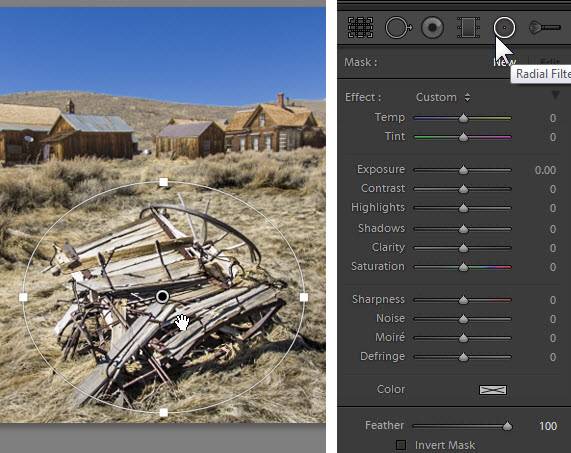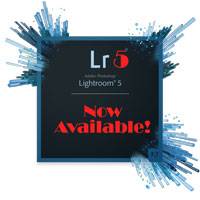Adobe announced the release of Lightroom 5.0 today, with essentially the same features made available in the beta version in April. Purchase the upgrade for $79 or the full version for $149 from Adobe here. Note the new system requirements at the bottom of this page — in a nutshell, Windows 7 or newer, Mac 10.7 (Lion) or newer.
With a shorter develop time than Lightroom 4, there are fewer new features than we have come to expect from previous releases, but I am happy with what has been added.
Below you will find a written description of what is new. Also check out:
- Lightroom 5 videos: highlight and feature-specific videos
- Video tutorial: How to Upgrade to Lightroom 5
Highlights of the release include:
- Much more powerful advanced healing brush capabilities in the spot removal tool: allowing for non-circular click-and-drag healing and cloning (my favorite new feature!); quick identification of spots with Visualize Spots:

- A Radial Filter for off-center vignetting and other elliptical local adjustments:

- Upright in Lens Corrections to automatically straighten photos and fix perspective:

- Smart Previews to allow for off-line editing of photos. These are lossy DNG files, stored with the catalog, that can be developed and otherwise used throughout Lightroom, even when the master files are off-line (i.e. on an external hard drive or server that is not available.) This allows for traveling with your catalog and previews on your laptop, without having to take the master files with you. Building smart previews also speeds up “Loading” time in the Develop module, as smart previews can be loaded before the masters.
- Grid and guide overlays for Library, Develop and tethered capture:

- True fullscreen mode (F) (old behavior: shift-F)
- Book: add and format page numbers, save page layouts (custom pages), cheaper “standard” paper type available, new more discoverable Add Text button
- Slideshow: videos can be included in slideshows; improved synchronization of slides with soundtrack duration
Other Miscellaneous
Managing Your Photos:
- A “Set as target collection” checkbox has been added to the Create Collection dialog.
- New Smart Collection criteria: size in megapixels, bit depth, number of color channels, color profile, smart preview status, PNG
- PNG file support (importing and editing)
- Lightroom will now import PNGs
- Edit-in Photoshop workflow is supported. The PNG will be converted either to a TIFF or PSD, based on the preferences that you have set
- PNG Transparency appears White
- PNG file type criterion in both smart collections and filters.
- New menu item to the View menu called “Lock Zoom Position”. If the menu item is checked, the zoom position of each image will be remembered, and when switching between images, the loupe view will be centered on the point you clicked last time.
- Ability to generate Previews with 2880 pixels on the long edge. These are Standard sized Previews and are an option within the Catalog Settings.
- Keyboard shortcut F12 to trigger tethered capture.
- “Direction” field in the EXIF Metadata panel. If the image contains GPS direction, then this field will show the compass directions as one of 8 options (North, Northwest, West, etc.). The degree value will shown as a tooltip on mouse hover. The “Direction” EXIF metadata field is editable. The 8 compass directions (North, North-west, east, etc.) are the only values that can be entered in this field. This field can be synced across multiple images using the “Sync Metadata” button.
- New Import option to Preferences. When ” Show the ‘Current/Previous Import’ collection during Import” is checked, the customer is shown their newly imported photos. When unchecked, the photos are still imported, but the focus will remain on the last previously viewed images (prior to Import).
- Photos can be dragged directly to Saved Locations and Saved Locations can be dragged to photos. In both cases, the photo will receive the same location as the already defined “Saved Location”.
- New command to verify the integrity of DNG files (Library>Validate DNG Files). Any invalid DNG files will be placed in a special collection. Only DNG files created by Adobe software can be validated (camera-‐created DNGs cannot be validated because they do not contain the necessary checksum).
- Windows HiDPI Support (15o% and 200% resolution)
Developing Your Photos:
- Faster entry into the Develop module (individual panels not loaded unless they’re open)
- Faster loading of photos in Develop (available preview used first)
- LAB color readout – right-click on the Histogram and select “Show LAB Color Values”
- Duplication of adjustment brush, graduated filter, and radial filter masks/corrections by Ctl/Cmd-Alt/Opt-dragging or clicking.
- Shift-Q to switch between heal and clone mode
- Before/After views in Develop now show current and proofed photo when soft proofing
- Aspect slider added to Lens Corrections Manual tab for small changes to help improve image’s appearance after corrections.
- Clipping indicators persistent between Lightroom sessions.
- Crop Overlay Aspect Ratios: Tools>Crop Guide Overlay > Aspect Ratios. Can be enabled using “O” in the crop tool.
Sharing Your Photos:
- New Publish Service to publish your images directly to Behance (http://www.behance.net/).
- The publish service for Behance in Lightroom interacts *only* with the “Work In Progress” (WIP) portion of the Behance site.
- Only one Lightroom collection is allowed per Behance publish service instance, and it cannot be renamed. Each photo published to Behance via a Behance publish service becomes a new WIP when it is first uploaded. Subsequent uploads of the same image become revisions to that WIP.
- User input is required during the actual publish operation; a dialog will request information related to each image during the upload process. This is necessary to encourage very deliberate user actions with respect to the important aspects of a Behance WIP.
Minimum System Requirements:
Windows®
• Intel® Pentium® 4 or AMD Athlon® 64 processor*
• DirectX 10–capable or later graphics card
• Microsoft® Windows® 7 with Service Pack 1 or Windows 8
• 2GB of RAM (4GB recommended)
• 2GB of available hard-disk space
• 1024×768 display
• DVD-ROM drive (for DVD version of software)
• Internet connection required for Internet-based services
Mac OS
• Multicore Intel processor with 64-bit support
• Mac OS X v10.7 or v10.8
• 2GB of RAM (4GB recommended)
• 2GB of available hard-disk space
• 1024×768 display
• DVD-ROM drive (for DVD version of software)
• Internet connection required for Internet-based services
Click here to go to highlight and detail videos on Lightroom 5 features.
[sc:signup]
